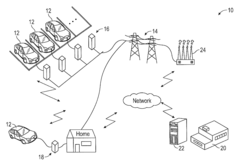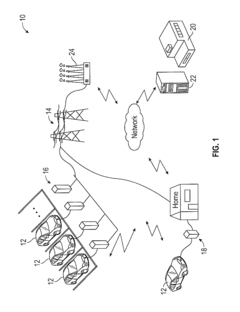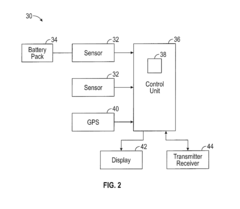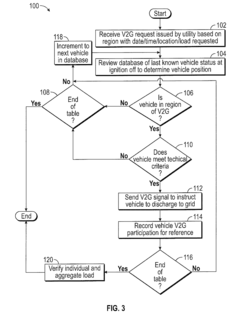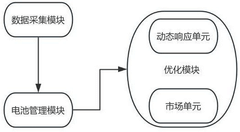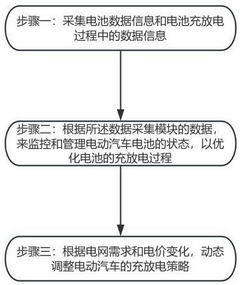V2G and Renewable Energy: Catalyzing a Sustainable Future
AUG 8, 20259 MIN READ
Generate Your Research Report Instantly with AI Agent
Patsnap Eureka helps you evaluate technical feasibility & market potential.
V2G and RE Background
Vehicle-to-Grid (V2G) technology and Renewable Energy (RE) integration represent a transformative approach to energy management and sustainability. This synergy has emerged as a response to the growing challenges of climate change, energy security, and grid stability. V2G technology enables electric vehicles (EVs) to not only draw power from the grid but also feed electricity back, effectively turning them into mobile energy storage units. This bidirectional flow of energy creates a dynamic ecosystem where EVs can support grid operations, particularly during peak demand periods.
The concept of V2G is rooted in the broader context of smart grid technologies and the increasing penetration of renewable energy sources. As countries worldwide commit to reducing carbon emissions, the integration of intermittent renewable energy sources like solar and wind has become crucial. However, the variable nature of these sources poses significant challenges to grid stability and reliability. This is where V2G technology offers a compelling solution, providing a flexible and distributed energy storage network through the batteries of electric vehicles.
The historical development of V2G can be traced back to the early 2000s when researchers began exploring the potential of using EVs as distributed energy resources. Since then, advancements in battery technology, power electronics, and communication systems have accelerated the feasibility and implementation of V2G systems. Concurrently, the rapid growth of renewable energy installations has created a pressing need for innovative grid balancing solutions, further driving interest in V2G technology.
Renewable energy sources, particularly solar and wind, have seen exponential growth over the past decade. This surge is driven by falling costs, improved efficiency, and supportive government policies aimed at decarbonizing the energy sector. The intermittent nature of these sources, however, necessitates advanced energy storage and management solutions to ensure grid stability and reliability. V2G technology offers a unique opportunity to address this challenge by leveraging the growing fleet of electric vehicles as a vast, distributed energy storage network.
The convergence of V2G and renewable energy technologies is creating new paradigms in energy management and sustainability. This integration promises to enhance grid flexibility, improve the utilization of renewable energy, reduce peak load demands, and provide ancillary services to the grid. As both electric vehicle adoption and renewable energy penetration continue to grow, the potential for V2G to play a pivotal role in shaping a sustainable energy future becomes increasingly evident.
The concept of V2G is rooted in the broader context of smart grid technologies and the increasing penetration of renewable energy sources. As countries worldwide commit to reducing carbon emissions, the integration of intermittent renewable energy sources like solar and wind has become crucial. However, the variable nature of these sources poses significant challenges to grid stability and reliability. This is where V2G technology offers a compelling solution, providing a flexible and distributed energy storage network through the batteries of electric vehicles.
The historical development of V2G can be traced back to the early 2000s when researchers began exploring the potential of using EVs as distributed energy resources. Since then, advancements in battery technology, power electronics, and communication systems have accelerated the feasibility and implementation of V2G systems. Concurrently, the rapid growth of renewable energy installations has created a pressing need for innovative grid balancing solutions, further driving interest in V2G technology.
Renewable energy sources, particularly solar and wind, have seen exponential growth over the past decade. This surge is driven by falling costs, improved efficiency, and supportive government policies aimed at decarbonizing the energy sector. The intermittent nature of these sources, however, necessitates advanced energy storage and management solutions to ensure grid stability and reliability. V2G technology offers a unique opportunity to address this challenge by leveraging the growing fleet of electric vehicles as a vast, distributed energy storage network.
The convergence of V2G and renewable energy technologies is creating new paradigms in energy management and sustainability. This integration promises to enhance grid flexibility, improve the utilization of renewable energy, reduce peak load demands, and provide ancillary services to the grid. As both electric vehicle adoption and renewable energy penetration continue to grow, the potential for V2G to play a pivotal role in shaping a sustainable energy future becomes increasingly evident.
Market Demand Analysis
The market demand for Vehicle-to-Grid (V2G) technology and renewable energy integration is experiencing significant growth, driven by the global push towards sustainable transportation and clean energy systems. As electric vehicle (EV) adoption continues to accelerate, the potential for V2G to provide grid services and support renewable energy integration has become increasingly apparent.
The EV market itself is a key driver of V2G demand. Global EV sales have been growing rapidly, with projections indicating a compound annual growth rate (CAGR) of over 20% in the coming years. This growth in the EV market directly translates to an expanding potential for V2G implementation, as each new EV represents a mobile energy storage unit that can participate in grid services.
Renewable energy integration is another crucial factor driving V2G market demand. As countries and utilities strive to increase the share of renewable energy in their power mix, the need for flexible grid resources to balance intermittent generation becomes more pressing. V2G technology offers a distributed solution to this challenge, enabling EVs to act as mobile energy storage units that can help smooth out supply and demand fluctuations.
The utility sector is showing increasing interest in V2G technology as a tool for grid management and optimization. Utilities are recognizing the potential of V2G to provide services such as frequency regulation, voltage support, and peak shaving. This interest is translating into pilot projects and partnerships with automakers and technology providers, further stimulating market demand.
Government policies and regulations are also playing a significant role in shaping V2G market demand. Many countries are implementing supportive policies, such as incentives for V2G-enabled vehicles and regulatory frameworks that allow for the participation of EVs in electricity markets. These policy measures are creating a more favorable environment for V2G adoption and market growth.
The corporate sector is another key driver of V2G market demand, particularly among companies with large vehicle fleets. Businesses are increasingly looking to electrify their fleets and integrate them with on-site renewable energy generation, creating opportunities for V2G implementation at scale.
Despite the growing market demand, challenges remain. These include the need for standardization of V2G technologies, concerns about battery degradation, and the complexity of integrating V2G systems with existing grid infrastructure. However, ongoing research and development efforts are addressing these challenges, paving the way for wider V2G adoption.
In conclusion, the market demand for V2G and renewable energy integration is robust and growing, driven by the convergence of EV adoption, renewable energy expansion, utility interest, supportive policies, and corporate sustainability initiatives. As technology continues to advance and barriers are overcome, the V2G market is poised for significant growth in the coming years, playing a crucial role in the transition to a more sustainable and resilient energy future.
The EV market itself is a key driver of V2G demand. Global EV sales have been growing rapidly, with projections indicating a compound annual growth rate (CAGR) of over 20% in the coming years. This growth in the EV market directly translates to an expanding potential for V2G implementation, as each new EV represents a mobile energy storage unit that can participate in grid services.
Renewable energy integration is another crucial factor driving V2G market demand. As countries and utilities strive to increase the share of renewable energy in their power mix, the need for flexible grid resources to balance intermittent generation becomes more pressing. V2G technology offers a distributed solution to this challenge, enabling EVs to act as mobile energy storage units that can help smooth out supply and demand fluctuations.
The utility sector is showing increasing interest in V2G technology as a tool for grid management and optimization. Utilities are recognizing the potential of V2G to provide services such as frequency regulation, voltage support, and peak shaving. This interest is translating into pilot projects and partnerships with automakers and technology providers, further stimulating market demand.
Government policies and regulations are also playing a significant role in shaping V2G market demand. Many countries are implementing supportive policies, such as incentives for V2G-enabled vehicles and regulatory frameworks that allow for the participation of EVs in electricity markets. These policy measures are creating a more favorable environment for V2G adoption and market growth.
The corporate sector is another key driver of V2G market demand, particularly among companies with large vehicle fleets. Businesses are increasingly looking to electrify their fleets and integrate them with on-site renewable energy generation, creating opportunities for V2G implementation at scale.
Despite the growing market demand, challenges remain. These include the need for standardization of V2G technologies, concerns about battery degradation, and the complexity of integrating V2G systems with existing grid infrastructure. However, ongoing research and development efforts are addressing these challenges, paving the way for wider V2G adoption.
In conclusion, the market demand for V2G and renewable energy integration is robust and growing, driven by the convergence of EV adoption, renewable energy expansion, utility interest, supportive policies, and corporate sustainability initiatives. As technology continues to advance and barriers are overcome, the V2G market is poised for significant growth in the coming years, playing a crucial role in the transition to a more sustainable and resilient energy future.
Technical Challenges
The integration of Vehicle-to-Grid (V2G) technology with renewable energy sources presents several significant technical challenges that need to be addressed for widespread adoption and optimal performance. One of the primary hurdles is the development of robust and efficient bidirectional charging systems. These systems must be capable of managing complex power flows between electric vehicles (EVs) and the grid while maintaining high efficiency and minimizing energy losses.
Another critical challenge lies in the design and implementation of advanced battery management systems. These systems must accurately monitor and control the state of charge, depth of discharge, and overall health of EV batteries to ensure their longevity and optimal performance in V2G applications. The frequent charging and discharging cycles associated with V2G operations can potentially accelerate battery degradation, necessitating sophisticated algorithms and control strategies to mitigate these effects.
Grid integration and stability pose significant technical hurdles for V2G and renewable energy systems. The intermittent nature of renewable energy sources, coupled with the variable availability of EVs for grid support, creates challenges in maintaining grid stability and power quality. Advanced forecasting algorithms, real-time monitoring systems, and intelligent control mechanisms are required to effectively manage the dynamic interplay between EVs, renewable energy sources, and the grid.
Standardization and interoperability present another set of technical challenges. The diverse range of EV models, charging standards, and grid protocols necessitates the development of universal communication interfaces and protocols to ensure seamless integration and operation of V2G systems across different regions and manufacturers. This standardization effort requires collaboration between automotive manufacturers, charging infrastructure providers, and utility companies.
Cybersecurity and data privacy concerns also pose significant technical challenges in the V2G ecosystem. The increased connectivity and data exchange between EVs, charging stations, and grid systems create potential vulnerabilities to cyber attacks. Robust encryption methods, secure authentication protocols, and advanced intrusion detection systems must be developed and implemented to protect sensitive user data and prevent unauthorized access to critical grid infrastructure.
Lastly, the development of sophisticated energy management and optimization algorithms represents a crucial technical challenge. These algorithms must efficiently coordinate the charging and discharging of large numbers of EVs while considering factors such as renewable energy availability, grid demand, electricity prices, and user preferences. Machine learning and artificial intelligence techniques may be employed to enhance the predictive capabilities and decision-making processes of these systems, ultimately maximizing the benefits of V2G technology in supporting renewable energy integration and grid stability.
Another critical challenge lies in the design and implementation of advanced battery management systems. These systems must accurately monitor and control the state of charge, depth of discharge, and overall health of EV batteries to ensure their longevity and optimal performance in V2G applications. The frequent charging and discharging cycles associated with V2G operations can potentially accelerate battery degradation, necessitating sophisticated algorithms and control strategies to mitigate these effects.
Grid integration and stability pose significant technical hurdles for V2G and renewable energy systems. The intermittent nature of renewable energy sources, coupled with the variable availability of EVs for grid support, creates challenges in maintaining grid stability and power quality. Advanced forecasting algorithms, real-time monitoring systems, and intelligent control mechanisms are required to effectively manage the dynamic interplay between EVs, renewable energy sources, and the grid.
Standardization and interoperability present another set of technical challenges. The diverse range of EV models, charging standards, and grid protocols necessitates the development of universal communication interfaces and protocols to ensure seamless integration and operation of V2G systems across different regions and manufacturers. This standardization effort requires collaboration between automotive manufacturers, charging infrastructure providers, and utility companies.
Cybersecurity and data privacy concerns also pose significant technical challenges in the V2G ecosystem. The increased connectivity and data exchange between EVs, charging stations, and grid systems create potential vulnerabilities to cyber attacks. Robust encryption methods, secure authentication protocols, and advanced intrusion detection systems must be developed and implemented to protect sensitive user data and prevent unauthorized access to critical grid infrastructure.
Lastly, the development of sophisticated energy management and optimization algorithms represents a crucial technical challenge. These algorithms must efficiently coordinate the charging and discharging of large numbers of EVs while considering factors such as renewable energy availability, grid demand, electricity prices, and user preferences. Machine learning and artificial intelligence techniques may be employed to enhance the predictive capabilities and decision-making processes of these systems, ultimately maximizing the benefits of V2G technology in supporting renewable energy integration and grid stability.
Current V2G Solutions
01 Grid integration and energy management
V2G technology enables electric vehicles to be integrated into the power grid, allowing for bidirectional energy flow. This integration helps in managing energy demand, balancing the grid, and improving overall energy efficiency. Advanced algorithms and control systems are used to optimize the charging and discharging of vehicles based on grid conditions and user preferences.- Grid integration and energy management: V2G technology enables electric vehicles to integrate with the power grid, allowing for bidirectional energy flow. This integration helps in managing energy demand, balancing the grid, and improving overall energy efficiency. Advanced algorithms and control systems are used to optimize the charging and discharging of vehicles based on grid conditions and user preferences.
- Renewable energy integration and storage: V2G technology supports the integration of renewable energy sources by using electric vehicles as distributed energy storage units. This helps in smoothing out the intermittency of renewable energy generation and provides a more stable and sustainable power supply. The technology enables better utilization of solar and wind energy, reducing reliance on fossil fuels.
- Economic incentives and business models: Sustainable V2G implementation requires innovative business models and economic incentives for vehicle owners. This includes developing fair pricing mechanisms, reward systems for grid services, and flexible energy trading platforms. These models aim to encourage participation in V2G programs while ensuring financial benefits for both vehicle owners and grid operators.
- Infrastructure and standardization: The sustainability of V2G technology depends on the development of robust charging infrastructure and standardized communication protocols. This includes the implementation of smart charging stations, secure data exchange systems, and interoperable standards for vehicle-to-grid communication. Standardization efforts focus on ensuring compatibility across different vehicle models and grid systems.
- Environmental impact and lifecycle assessment: Assessing the environmental impact of V2G technology throughout its lifecycle is crucial for ensuring long-term sustainability. This includes analyzing the carbon footprint of manufacturing and operating V2G-enabled vehicles and infrastructure, as well as evaluating the potential for reducing greenhouse gas emissions through improved grid efficiency and renewable energy integration.
02 Renewable energy integration and storage
V2G technology supports the integration of renewable energy sources by using electric vehicles as distributed energy storage units. This helps in mitigating the intermittency of renewable energy and enhances grid stability. The technology allows for storing excess renewable energy during off-peak hours and feeding it back to the grid during peak demand periods.Expand Specific Solutions03 Economic incentives and business models
Sustainable V2G implementation requires the development of innovative business models and economic incentives. This includes creating pricing structures that encourage vehicle owners to participate in V2G programs, developing revenue-sharing mechanisms between utilities and vehicle owners, and implementing smart contracts for automated transactions.Expand Specific Solutions04 Infrastructure and standardization
The sustainability of V2G technology depends on the development of robust charging infrastructure and standardization of protocols. This involves creating interoperable charging stations, developing communication standards between vehicles and the grid, and ensuring cybersecurity measures to protect the grid and user data.Expand Specific Solutions05 Environmental impact and lifecycle assessment
To ensure the long-term sustainability of V2G technology, it is crucial to assess its environmental impact throughout the lifecycle of electric vehicles and associated infrastructure. This includes analyzing the carbon footprint of battery production, evaluating the impact of increased cycling on battery life, and developing strategies for recycling and repurposing EV batteries.Expand Specific Solutions
Key Industry Players
The V2G and renewable energy sector is in a dynamic growth phase, characterized by increasing market size and evolving technological maturity. The competitive landscape is diverse, featuring established automotive giants like Honda and Hyundai Mobis alongside specialized EV charging companies such as ChargePoint. Major power grid operators, including State Grid Corporation of China and its subsidiaries, are actively involved in developing V2G infrastructure. Research institutions like the Chinese Academy of Science Guangzhou Energy Research Institute and universities such as Shanghai Jiao Tong University are driving innovation in this field. The market is seeing a convergence of automotive, energy, and technology sectors, with companies like Ballard Power Systems contributing to the advancement of fuel cell technology. As the technology matures, we can expect increased collaboration and competition among these diverse players.
State Grid Corp. of China
Technical Solution: State Grid's V2G approach focuses on large-scale integration of EVs into China's national power infrastructure. Their solution includes the development of high-power bidirectional charging stations capable of handling multiple vehicles simultaneously[1]. State Grid has implemented advanced grid management systems that can predict and respond to fluctuations in renewable energy generation, using EVs as a flexible resource to balance supply and demand[2]. The company is also investing in smart grid technologies, including AI-driven load forecasting and real-time power flow optimization, to maximize the benefits of V2G in supporting renewable energy integration[3]. State Grid has launched pilot projects in several cities, demonstrating V2G's potential to enhance grid resilience and reduce the need for traditional peaker plants[4].
Strengths: Massive scale and resources, direct control over grid infrastructure, strong government support. Weaknesses: Potential bureaucratic challenges, need for coordination with multiple EV manufacturers.
ChargePoint, Inc.
Technical Solution: ChargePoint's V2G solution combines their extensive charging network with advanced energy management software. Their system enables intelligent charging that responds to grid signals, allowing EVs to charge when renewable energy is abundant and potentially discharge power back to the grid during peak demand[1]. ChargePoint's networked charging stations are equipped with bidirectional capabilities, supporting both AC and DC V2G implementations[2]. The company's cloud-based platform integrates with utility systems, enabling seamless communication and control for grid services[3]. ChargePoint has also developed a user-friendly mobile app that allows EV owners to participate in V2G programs while maintaining control over their vehicle's state of charge[4].
Strengths: Large existing charging infrastructure, advanced software capabilities, and experience in grid integration. Weaknesses: Reliance on partnerships for vehicle-side integration, potential scalability challenges in residential V2G applications.
Core V2G Innovations
Priority based vehicle control strategy
PatentActiveUS20160075247A1
Innovation
- A method and system that prioritize V2G requests by determining which vehicles in a specific geographic region meet criteria established to reduce battery degradation, using historical and current data to select vehicles for participation, thereby limiting the number of charge and discharge cycles and extending the battery life.
A dynamic regulation system and method for electric vehicles participating in power grid based on V2G technology
PatentActiveCN118651117B
Innovation
- The data acquisition module is used to monitor battery status. The battery management module dynamically adjusts the charge and discharge strategy based on comprehensive evaluation values and changes in electricity prices. The optimization module includes a dynamic response unit and a market unit, a predictive maintenance unit and a charge and discharge adjustment factor to achieve intelligent charge and discharge management and economy. excitation.
Policy and Regulations
The policy and regulatory landscape surrounding Vehicle-to-Grid (V2G) technology and renewable energy integration is rapidly evolving to support the transition towards a sustainable energy future. Governments worldwide are recognizing the potential of V2G systems to enhance grid stability, reduce carbon emissions, and accelerate the adoption of renewable energy sources.
At the national level, many countries are implementing supportive policies to encourage V2G adoption. These include financial incentives for electric vehicle (EV) owners who participate in V2G programs, tax credits for V2G-enabled charging infrastructure, and mandates for utilities to incorporate V2G capabilities into their grid management strategies. For instance, the United Kingdom has launched a series of V2G pilot projects backed by government funding, while Japan has integrated V2G into its national energy strategy.
Regulatory frameworks are being updated to accommodate the unique characteristics of V2G systems. Grid operators are developing new rules and standards for bidirectional power flow, ensuring that V2G-enabled vehicles can safely and efficiently interact with the electricity grid. These regulations address issues such as communication protocols, power quality standards, and cybersecurity measures to protect both the grid and vehicle owners.
Energy market reforms are also underway to create opportunities for V2G participation. Many jurisdictions are introducing dynamic pricing mechanisms and real-time energy markets that allow EV owners to monetize their vehicle's battery capacity by providing grid services. Regulators are working to remove barriers to entry for aggregators, who can pool multiple EVs to provide significant grid support services.
Environmental regulations are increasingly recognizing the role of V2G in reducing greenhouse gas emissions. Some countries are incorporating V2G capabilities into their renewable energy targets and carbon reduction strategies. For example, the European Union's Clean Energy Package includes provisions that support the integration of EVs and V2G technology into the broader energy system.
However, challenges remain in harmonizing regulations across different regions and ensuring interoperability of V2G systems. Policymakers are working to develop common standards and protocols to facilitate cross-border V2G operations and create a more unified market for these services.
As the technology matures, policy and regulatory frameworks will need to evolve to address emerging issues such as data privacy, consumer protection, and fair compensation for grid services provided by EV owners. The success of V2G in catalyzing a sustainable future will depend on the continued development of supportive and adaptive policy environments that balance innovation with grid stability and consumer interests.
At the national level, many countries are implementing supportive policies to encourage V2G adoption. These include financial incentives for electric vehicle (EV) owners who participate in V2G programs, tax credits for V2G-enabled charging infrastructure, and mandates for utilities to incorporate V2G capabilities into their grid management strategies. For instance, the United Kingdom has launched a series of V2G pilot projects backed by government funding, while Japan has integrated V2G into its national energy strategy.
Regulatory frameworks are being updated to accommodate the unique characteristics of V2G systems. Grid operators are developing new rules and standards for bidirectional power flow, ensuring that V2G-enabled vehicles can safely and efficiently interact with the electricity grid. These regulations address issues such as communication protocols, power quality standards, and cybersecurity measures to protect both the grid and vehicle owners.
Energy market reforms are also underway to create opportunities for V2G participation. Many jurisdictions are introducing dynamic pricing mechanisms and real-time energy markets that allow EV owners to monetize their vehicle's battery capacity by providing grid services. Regulators are working to remove barriers to entry for aggregators, who can pool multiple EVs to provide significant grid support services.
Environmental regulations are increasingly recognizing the role of V2G in reducing greenhouse gas emissions. Some countries are incorporating V2G capabilities into their renewable energy targets and carbon reduction strategies. For example, the European Union's Clean Energy Package includes provisions that support the integration of EVs and V2G technology into the broader energy system.
However, challenges remain in harmonizing regulations across different regions and ensuring interoperability of V2G systems. Policymakers are working to develop common standards and protocols to facilitate cross-border V2G operations and create a more unified market for these services.
As the technology matures, policy and regulatory frameworks will need to evolve to address emerging issues such as data privacy, consumer protection, and fair compensation for grid services provided by EV owners. The success of V2G in catalyzing a sustainable future will depend on the continued development of supportive and adaptive policy environments that balance innovation with grid stability and consumer interests.
Environmental Impact
The integration of Vehicle-to-Grid (V2G) technology and renewable energy sources has the potential to significantly reduce the environmental impact of both the transportation and energy sectors. By enabling electric vehicles (EVs) to serve as mobile energy storage units, V2G systems can help balance the intermittent nature of renewable energy sources, leading to a more stable and sustainable power grid.
One of the primary environmental benefits of V2G technology is its ability to support the increased adoption of renewable energy sources. As wind and solar power generation can be variable, the energy storage capacity provided by EVs can help smooth out supply fluctuations. This reduces the need for fossil fuel-based peaker plants, which are typically used to meet sudden spikes in energy demand. Consequently, V2G implementation can lead to a substantial reduction in greenhouse gas emissions associated with electricity generation.
Furthermore, V2G technology can enhance the overall efficiency of the power grid by optimizing energy distribution. During periods of low demand, excess renewable energy can be stored in EV batteries, preventing waste and reducing the need for curtailment of renewable energy sources. This stored energy can then be fed back into the grid during peak demand periods, reducing strain on the system and minimizing the use of less environmentally friendly power sources.
The widespread adoption of V2G technology also has the potential to accelerate the transition to electric vehicles. By providing EV owners with the opportunity to generate revenue through grid services, V2G can make electric vehicles more economically attractive. This, in turn, can lead to a faster reduction in tailpipe emissions from the transportation sector, which is a significant contributor to global greenhouse gas emissions.
Additionally, V2G systems can contribute to the development of more resilient and decentralized energy networks. By distributing energy storage across numerous vehicles, the grid becomes less vulnerable to large-scale outages and more capable of responding to localized energy needs. This increased resilience can reduce the environmental impact associated with power failures and the need for backup generators.
However, it is important to consider the potential environmental trade-offs associated with V2G technology. The increased cycling of EV batteries may lead to faster degradation, potentially resulting in more frequent battery replacements. This could have implications for resource consumption and waste management in the battery production and recycling industries. Therefore, ongoing research and development in battery technology and recycling processes are crucial to maximizing the environmental benefits of V2G systems.
In conclusion, the integration of V2G technology with renewable energy sources presents a promising pathway towards a more sustainable and environmentally friendly energy ecosystem. By addressing the challenges of intermittent renewable energy generation, supporting grid stability, and accelerating the adoption of electric vehicles, V2G has the potential to significantly reduce carbon emissions and mitigate the environmental impact of both the transportation and energy sectors.
One of the primary environmental benefits of V2G technology is its ability to support the increased adoption of renewable energy sources. As wind and solar power generation can be variable, the energy storage capacity provided by EVs can help smooth out supply fluctuations. This reduces the need for fossil fuel-based peaker plants, which are typically used to meet sudden spikes in energy demand. Consequently, V2G implementation can lead to a substantial reduction in greenhouse gas emissions associated with electricity generation.
Furthermore, V2G technology can enhance the overall efficiency of the power grid by optimizing energy distribution. During periods of low demand, excess renewable energy can be stored in EV batteries, preventing waste and reducing the need for curtailment of renewable energy sources. This stored energy can then be fed back into the grid during peak demand periods, reducing strain on the system and minimizing the use of less environmentally friendly power sources.
The widespread adoption of V2G technology also has the potential to accelerate the transition to electric vehicles. By providing EV owners with the opportunity to generate revenue through grid services, V2G can make electric vehicles more economically attractive. This, in turn, can lead to a faster reduction in tailpipe emissions from the transportation sector, which is a significant contributor to global greenhouse gas emissions.
Additionally, V2G systems can contribute to the development of more resilient and decentralized energy networks. By distributing energy storage across numerous vehicles, the grid becomes less vulnerable to large-scale outages and more capable of responding to localized energy needs. This increased resilience can reduce the environmental impact associated with power failures and the need for backup generators.
However, it is important to consider the potential environmental trade-offs associated with V2G technology. The increased cycling of EV batteries may lead to faster degradation, potentially resulting in more frequent battery replacements. This could have implications for resource consumption and waste management in the battery production and recycling industries. Therefore, ongoing research and development in battery technology and recycling processes are crucial to maximizing the environmental benefits of V2G systems.
In conclusion, the integration of V2G technology with renewable energy sources presents a promising pathway towards a more sustainable and environmentally friendly energy ecosystem. By addressing the challenges of intermittent renewable energy generation, supporting grid stability, and accelerating the adoption of electric vehicles, V2G has the potential to significantly reduce carbon emissions and mitigate the environmental impact of both the transportation and energy sectors.
Unlock deeper insights with Patsnap Eureka Quick Research — get a full tech report to explore trends and direct your research. Try now!
Generate Your Research Report Instantly with AI Agent
Supercharge your innovation with Patsnap Eureka AI Agent Platform!
